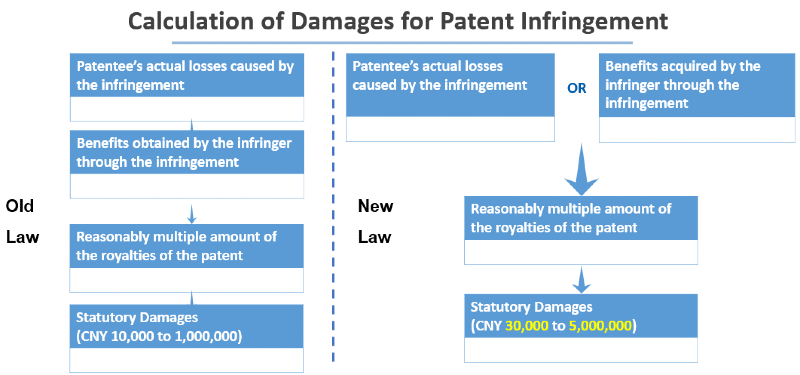Patent Enforcement in China – How to Do It Systematically?
Written by Haoyu ZHOU (Elliot) and Fei MA (Ms.)
In the new Chinese Patent Law which is about to take effect on June 1, 2021, several changes are related to the improvement of patent enforceability. Remarkably,
-(1) the statutory damages for patent/design infringement will be increased to a maximum of CNY 5 million;
-(2) the patentee’s actual loss AND the illegal proceeds obtained by the infringer will be considered equally important in calculating the damages; and
-(3) the punitive damages of up to 5-fold will be introduced.
Some of these important changes are shown in the chart below.

Since these changes may collectively alter the practice of patent enforcement in China, we will illustrate herewith a systematic way of enforcing the Chinese patent, especially under the new Patent Law.
(1) Desktop Investigation and Notarization of the Evidence
For most of the time, the infringers and their infringement acts were first detected on E-commerce platforms such as Taobao, Tmall, JD, B2B and the like. Occasionally, the infringers may also be found in an Exhibition, displaying the products at a booth or a roadshow.
Because China does not have a discovery procedure as part of the court proceeding, the patent owner must bear the burden to collect and fix the evidence on their own initiative.
Strategically, before immediately sending out a warning letter to the other party, the patent owner is highly recommended to conduct a desktop investigation by knowing who the infringer is, their legal representatives, business address, contact numbers, emails, registered capital and commercial scale, etc. After that, it would be advisable to call for a Chinese notary officer and have the relevant webpages, brochures, business card, advertisement and product information notarized. In other words, it would be necessary to notarize the ongoing infringement and the evidence that is easy to be erased. If the evidence is not notarized, then the patent owner may hardly prove the facts at the court proceeding if the infringer destroys or conceals the information in relation to the infringement.
Regarding the infringer’s sales revenue and illegal proceeds, they are in most cases not easy to obtain. That is why a large number of patent infringement litigations end up with only statutory damages.
In order to increase the bargaining power for damages, the patent owner is recommended to collect at least some preliminary evidence before filing the lawsuit. Strategically, the patent owner may look for sales information such as (1) data published on the E-commerce platform, (2) data published by the industrial association, (3) financial reports of the listed company, (4) bidding information, and (5) royalties for patent licensing, etc. These steps can be done with the help of a patent litigator or investigator.
(2) Sending out C&D letter
After the evidence above is notarized and fixed, the patent owner may send out the cease and desist (C&D) letter to the other party.
In recent months, partly because of the upcoming punitive damages, we have seen more and more infringers agree to voluntarily remove the relevant webpages and advertisement after receiving the letter, or even actively reach out to be a patent licensee.
On the contrary, if the infringer explicitly indicates that they will not stop the normal business after receiving the C&D letter, the patent owner could rely on this response as a gesture for “intentional infringement”, and may claim for punitive damages in a subsequent court proceeding.
(3) Choosing Courts
According to our experience, the courts at economically more developed cities are usually more professional in trial and decision making, and they tend to award higher damages for patent infringement cases. Good examples are IP courts based in Beijing, Shanghai and Shenzhen. A few intermediate courts based in coastal cities, like Hangzhou and Guangzhou, are also good choices. However, with the rapid increase of IP dispute cases over the years in Hangzhou and Guangzhou, the courts at these jurisdictions seem to have accumulated a huge backlog of cases and may take much longer time for trial than used before. Therefore, if the patent owner wants a quick injunction and faster decision, courts at Zhejiang and Guangdong provinces might not be a favorable option.
The courts at smaller cities may not be favorable either, because these courts will take more consideration of the economic status of the city and the infringer’s contribution to the local GDP. As a result, the damages awarded could be lower.
Therefore, if more than one court can be chosen, the patent owner may preferably choose the one in first-tier cities or top second-tier cities, where the damages awarded by the court are usually higher. However, because of the strict scope of jurisdictions in China, the patent owner may not have much freedom for forum shopping though.
(4) Requesting for Preservation of Evidence, Property or Act
If the patent owner can’t easily obtain the infringer’s sales data from the public channel, then another approach would be to request the court for preserving the evidence, before or during the court proceeding. The court will then order the other party to provide the account book, for example.
If the patent owner worries that the infringer may transfer the properties, then the patent owner may also request the court to preserve the properties of the infringer, before or during the court proceeding. In most circumstances however, collaterals may be needed by the court.
Regarding the preservation of acts (such as an injunction), it may also be possible upon a request of the plaintiff. Although the pre-litigation temporary injunction is possible in China, however, this is only for situations where a continued infringement would lead to a consequence of “irreparable loss” to the patent owner, public interest or national interest. Partly due to the high threshold for such “irreparable loss”, we seldom see courts issue pre-litigation temporary injunctions against patent infringement in daily practice.
If you have any questions about patent enforcement and litigation, please feel free to contact Mr.Elliot ZHOU or Ms. Fei MA at patent@foundin.cn. We are glad to provide further advices.

 adm
adm


